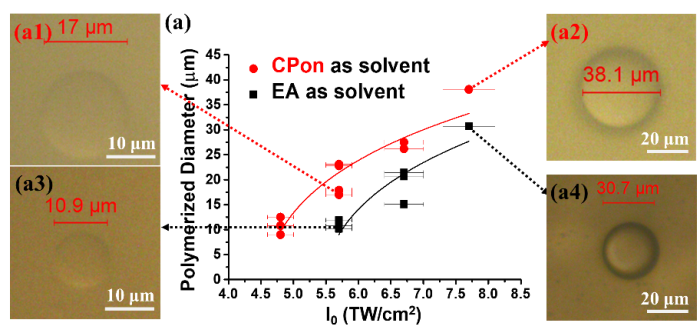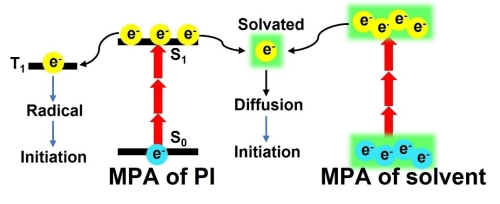Recently, researchers from the Shanghai Institute of Optics and Fine Mechanics (SIOM) of the Chinese Academy of Sciences (CAS) have proposed an easy method to improve the efficiency of multi-photon polymerization via introducing nonlinear solvents. Nonlinear solvents were added to photoresists. Based on the superposition of the nonlinear absorption, the threshold of Multi-photon Polymerization (MPP) has been reduced, and the process window has been broadened. Also, it could be employed to refine the feature size of MPP manufacturing. The relevant study has been published in Optics and Laser Technology on March 1, 2022.
Femtosecond laser-induced MPP manufacture is widely used to directly write 3D micro-structures in the fields of Micro-electromechanical Systems (MEMS), micro-optics, and biogenetic texture et al. The finest feature can achieve ~10nm via the Multi-photon Absorption (MPA) of photoresists. The manipulation of the polymerized threshold of photoresists is an important approach to optimizing the feature size and efficiency of laser manufacturing. The core to adjusting the MPP threshold is to design and synthesize the photo-initiators (PIs) in photoresists. After analyzing the photo-physical-chemical process of photoresists after being exposed to a femtosecond laser pulse, the research group find out that the MPA of solvents in photoresist can also define the MPP efficiency and resolution. Experiments have been carried out. The method based on introducing nonlinear solvents into photoresists has been verified.
The researchers selected three commercial PIs (IRG369, ISO, and TPO) to resolve in four solvents (THF, CPon, EA, and Ethanol). There is MPA in the solvent THF and CPon, but not in EA and Ethanol. Compared with PIs in linear solvents, the MPA threshold of PIs in nonlinear solvents could be reduced by ~23% mostly. Meanwhile, the MPA intensity has also been promoted. Furtherly, the PI, TPO, and the monomer PETA have been mixed into solvent CPon (nonlinear, as photoresist A) and EA (linear, as photoresist B), respectively. A single-pulse long-focal femtosecond MPP exposure system has been employed to verify the impact of nonlinear solvent in a photoresist. The exposed results reveal that the MPP threshold of photoresist A has been reduced by ~16% according to the nonlinear solvent CPon.
This finding could propose a new and easy method to optimize the MPP process window, efficiency, and feature size of the photoresist. The superposition and enhancement of MPA of the contents in solutions, which could be employed to optimize photoresists used in fs MPP manufacturing and UV fields, has also been verified. Furthermore, the phenomenon can also be used to refine other solvated nonlinear optical technologies, such as two-photon spectroscopy or two-photon fluorescence imaging.


Figure 1. (a) Statistics of polymerized diameters of photoresists A and B. (b) MPA performances of TPO in the solvent CPon/EA and CPon itself. (Image by SIOM)

Figure 2. Another approach to initiate and promote MPP: the hypothesis of solvated electrons. (Image by SIOM)
Article website:
https://doi.org/10.1016/j.optlastec.2022.108008
Contact:
WU Xiufeng
General Administrative Office
Shanghai Institute of Optics and Fine Mechanics, CAS
Email: xfwu@siom.ac.cn
Web: http://english.siom.cas.cn/